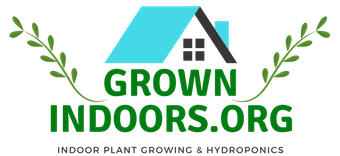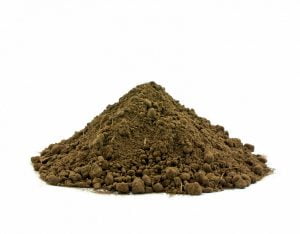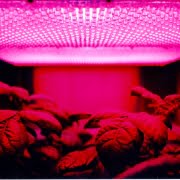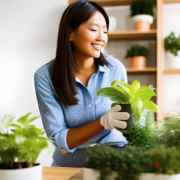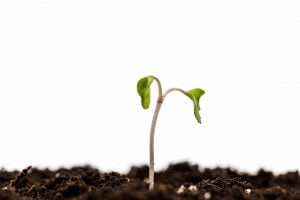 Indoor gardening could mean anything from having a few plants hanging by the windowsill to a full-fledged indoor garden. It really all depends what your end goal is as an indoor gardener. I knew from the beginning that I wanted to concentrate on growing a variety of vegetables.
Indoor gardening could mean anything from having a few plants hanging by the windowsill to a full-fledged indoor garden. It really all depends what your end goal is as an indoor gardener. I knew from the beginning that I wanted to concentrate on growing a variety of vegetables.
But, before I learned about how cilantro grows, or how carrots grow or even how mustard greens grow, I had to learn the top 4 basic principles of Indoor Gardening. Keep reading to find out what you need to know to become the best indoor gardener that you can possibly become.
Indoor Gardening 101
Basic #1 – Indoor Garden Lighting
There are plants you can raise indoors without supplemental light. These tend to be plants that naturally grow on the forest floor or the second tier of the forest – they’re used to shade. African violets, ivy and other common houseplants fall into this category.
There are vegetables and herbs that can grow indoors with natural light from a window provided it streams in for enough hours a day. However, you may need to supplement with grow lights.

For example, fruiting vegetables or herbs do best with 10 plus hours a day of light, and you may not be receiving that through your biggest window in the winter. If you’re trying to get long day plants to flower, those that are programmed to flower during the summer, they need 14 to 18 hours of light.
Another factor to consider is spacing of the plants. If you put all the plants in the window, they’ll be exposed to that maximum amount of natural sunlight, but they may be exposed to colder air leaking in through the window than if you placed them in the corner under a grow light. If the plants are on shelves, there is the possibility the shelves themselves shade lower plants from the natural light.
You could supplement with grow lights or simply put grow lights on all of the shelves. Just make sure the lights aren’t too close to the plants, since light too close could sunburn the plants or simply overheat them. You can read my post on the Top 5 LED Grow Lights of 2018 to get more info on the different brands of grow lights on the market right now.
Artificial lighting becomes critical when you’re trying to maximize certain aspects of a plant’s growth. Red light stimulates leaves, while blue light stimulates the stems. Broad spectrum grow lamps provide both. One such grow lamp that I currently use and highly recommend is the Galaxyhydro 300w LED Grow Light which you can find on Amazon.com right now for a great price.
If you’re trying to delay flowering in plants or maximize leaf production for certain vegetables, advanced grow lights become essential. If you’re growing garlic and mint in a pot, that’s overkill.
Basic #2 – Soil/Growing Medium
The growing medium is simply what your plants are growing in. A pot full of soil scraped up from outside has its growing medium. Or it could be cuttings sitting in water as they grow roots before you transplant them to soil, another growing medium. It is rare that someone actually needs a hydroponics or airponics system.
The ideal growing medium is loose and drain wells but holds moisture so that the roots can absorb it while nutrients don’t drain away. You can create your own or buy it. Note that the ideal growing medium for your plants depends on the plants themselves, since some plants need different soil pH or varying soil qualities.
Most potting “soils” actually don’t contain soil. They’re made from a mix of peat, sand, and perlite (to improve drainage). A few more expensive mixtures contain water-retaining crystals to slow the release of water into the soil so you don’t have to water as often.
You can find specialized potting mixes for hard to raise plants like orchids and cacti, but most plants you’d like to raise indoors can be raised in any sterile commercial mix intended for indoor plants. It’s the soil from the weedy lot outside that could bring in unwanted seeds, pests and fungus that’s more likely to be an issue.
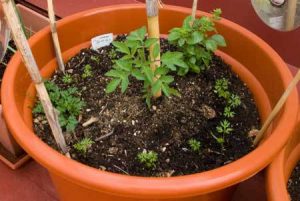 Another issue is the container you put the plant in. Always research how much space the plant needs, since putting a plant that needs 8” of depth in a 4” tray means you’ll fail to raise a healthy crop no matter how well-lit and watered it is. They need adequate space for the roots to grow out and down. The amount of space they need vertically varies, too.
Another issue is the container you put the plant in. Always research how much space the plant needs, since putting a plant that needs 8” of depth in a 4” tray means you’ll fail to raise a healthy crop no matter how well-lit and watered it is. They need adequate space for the roots to grow out and down. The amount of space they need vertically varies, too.
When selecting pots or planters (Link to Amazon.com), look for ones with weep holes so it can drain out extra water; this will happen even if you’re watering it perfectly. Yes, you’re going to want a tray or pad under the plants to absorb this extra water. If they don’t have weep holes, the water-logged soil could suffocate the plant roots.
If you’re doing well, you can tell the plant needs to be moved to a larger pot because the roots are growing out the drainage holes. A plant that has no new growth probably needs to be moved to a larger container as well.
Basic #3 – What About Watering
All plants need to be watered. Whether you need to mist them daily or drench them every other day depends on the species. If you’re growing a mix of plants indoors, learn what their watering schedule needs to be or set up automatic watering systems (Link to Amazon.com) to water them for you. This is where putting the same plant on the same row simplifies things dramatically.
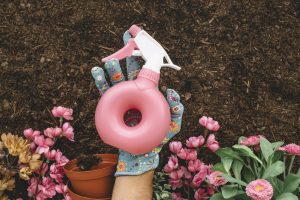 Plants also need a certain level of humidity. And the modern home runs too dry, especially in the winter. Don’t assume that a high level of humidity from misters or dripping from other plants reduces your need to water the plants.
Plants also need a certain level of humidity. And the modern home runs too dry, especially in the winter. Don’t assume that a high level of humidity from misters or dripping from other plants reduces your need to water the plants.
However, you know that the plants are suffering from low humidity if the plants are withered, puckered, turning brown or losing their leaves. Don’t put plants in a tray of water to try to offset humidity, since this may over-water the roots or foster fungal growth.
An indoor gardening 101 note for new gardeners – you can use tap water in some cases but distilled water is better. Don’t use water leftover from cooking or other applications to water the plants, since it probably contains salts and food residue that your plants shouldn’t be exposed to.
Basic #4 – Temperature
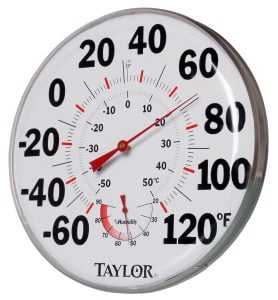 Most plants we regularly grow indoors need temperatures of 65 degrees to 75 degrees Fahrenheit. A good indicator that it is too cold for the plants is yellowing of the leaves. This is where grow lights can cause plants to overheat, so be careful as to the right distance of the bulbs from the plants. The right distance varies between species, but too far means they don’t get enough intensity while too close means they get too much and risk overheating.
Most plants we regularly grow indoors need temperatures of 65 degrees to 75 degrees Fahrenheit. A good indicator that it is too cold for the plants is yellowing of the leaves. This is where grow lights can cause plants to overheat, so be careful as to the right distance of the bulbs from the plants. The right distance varies between species, but too far means they don’t get enough intensity while too close means they get too much and risk overheating.
Sometimes plants are brought indoors after sitting on the deck or windowsill. Even these plants that need to be brought inside need to be acclimated by potting them, letting them spend some time in a shady spot part of the day to get them to thin their cuticle, and then move them inside.
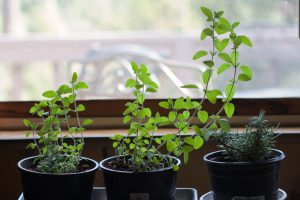 If you were moving plants from your indoor garden to the outdoors, they’d need some time spent in direct sunlight that increases by an hour or two a day. This forces the plant to grow a thicker cuticle and prevents excessive water loss.
If you were moving plants from your indoor garden to the outdoors, they’d need some time spent in direct sunlight that increases by an hour or two a day. This forces the plant to grow a thicker cuticle and prevents excessive water loss.
They’ll need to spend the night indoors for at least a week regardless of which way they’re going. This ensures that the garden plant that’s adapting for cold fall weather doesn’t get sick when you put it in indoor garden and that the seedlings you started off indoors don’t die when you plant them outside.
Conclusion
Just like learning and mastering anything else, indoor gardening is no exception, but it’s very rewarding. You will be in a position where you are growing your own vegetables, flowers, house plants etc. and also have the enjoyment of seeing a seed that you planted and nurtured come to fruition. For more information about indoor gardening visit the following link: https://en.wikipedia.org/wiki/Hydroponics or view the video below:
